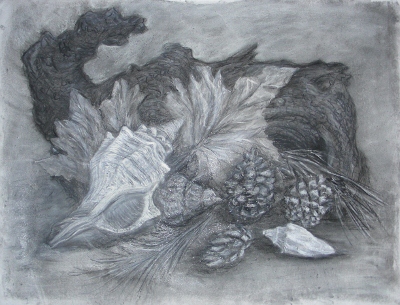Still Life of Natural Objects
I am now doing my first assignment for evaluation by my tutor. The brief is to produce two still life works with preparatory drawings in different media. The first work is to be comprised of natural objects. I chose some shells, leaves, pine cones and a piece of wood and move them around until I found an arrangement which pleased me and then proceeded to do a first version in pen and ink. I started by using a bamboo stick to get a natural looking line but this was difficult as there was either too much ink or too little. Though the lines were pleasing in themselves I gave up and moved to using a pen and at times a brush. The drawing got rather messy in the lighter areas so I painted these over with white acrylic and drew them over again. I was quite pleased with the end result. I have rarely used ink as a medium but will aim to do this more often. I like the strong contrasts which are produced.
 |
| Pen and Ink Drawing |
|
|
|
|
|
|
The next work was a drawing of the same arrangement using soft pastels, pencil and white acrylic paint.
Soft Pastel Drawing
The last drawing in the series was done in charcoal and white chalk.
 |
| Still Life with Charcoal and white chalk |
|
The drawings took me much longer than was suggested in the brief. I find it hard to complete work in one session. I need to leave it in
order to come back with a fresh eye to address parts that don't work
that well. I tend to rework several times and get a
bit over concerned with details and the work is liable to lose it's
freshness.
For the second still life work with man made objects, I chose an Indonesian puppet, a bottle and a Moroccan teapot. I found an arrangement that seemed to work and did some sketches.
This didn't feel like enough objects so I added a wine glass and did another quick sketch.
This worked much better so I started a drawing in charcoal on A2 paper.
Charcoal Still Life with Puppet etc.
I liked this one as it was a bit looser than the previous work. I followed it with a drawing in soft pastels.
 |
| Still Life with Puppet in soft pastels |
I feel I overworked this drawing. My intent was to produce something a bit more interpretive but I got sucked into the realistic approach again. The pastels I have are not the best quality and I went over the drawing quite a lot to try to strengthen the colour and contrast but with dubious success.
In doing this work I have realised how important it is to use the appropriate paper for the medium. My charcoal drawings were done on smooth cartridge paper and it was hard to get the contrast I wanted and the drawing was very easily smudged. I used a rougher paper for the soft pastel drawing and it was much easier to control.
Overall, though I am quite pleased with my assignment drawings, I feel my approach was too literal and fussy. These are habits of a lifetime that I want to break free from in order to move to a looser more interpretive style. I have been looking at the work of other students and some are doing really exciting original and contemporary work. I hope to move in this direction in the next assignment.
Before winding up this first assignment I decided to try a more interpretive approach and tried some cubist style pencil sketches.......
I then did an A1 size under-painting in acrylic and when I was satisfied with the compostion (intended to give an impression of the puppet springing into life) I worked into it with graphite pencil and pastels. The pastels adhered quite well to the acrylic especially after spraying the surface with fixative.
 |
| Cubist style puppet drawing |
|
|
I'm now going to take my assignment work to the post office to send to my tutor. Hope it arrives intact!












.jpg)


































